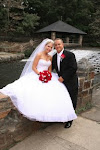
When I take my studio on the road, I follow the rule for great photography: great subject, great light and great background. I use only artist painted backgrounds. I like Owens Originals best because of their quality and great price. I like a stormy sky with hints of blue. I also use a "friendly" blue sky for most of my school portraits. My favorite lighting is the Alien Bees mono light. It is light weight and powerful. For the above portrait I used a simple set up with one key light with umbrella placed high, lighting the "mask" of the face; I used a silver reflector, throwing reflected light from the key unto the unlit side of the face; I used a hairlight with an umbrella placed high in back of the subject. BUT what makes this portrait adored by the subject--I used a very expensive Nikon soft filter. A good soft filter will SOFTEN but not BLUR. There are plenty of techniques to blur or render out of focus, but for a successful portrait you need to SOFTEN the image and maintain RAZOR SHARP-FOCUS.
Additional comment!!! I've noticed a trend (with the popularity of consumer digital cameras and Hi-def TV) for all photos to be razor sharp. Soft-focus has temporarily taken a back seat to hyper airbrushing using PhotoShop. I've been guilty of this for a long time getting complaints from some customers that I make them look too good!
I've discovered a way to create impeccable soft focus effects after the image has been made with the camera, using PhotoShop and NO airbrushing. Here it is in it's simplest form. With Layers, create a duplicate top layer.
Blur heavily the top layer using Gaussian Blur in Filters. With both layers open for view, take top layer and make it less opaque using the slider to 15 to 20% or until it looks good to you. This technique puts any expensive filter to shame and comes in very handy for portrait photography. You can maintain a sharp image or soften it as much as you like.
The principal is that the bottom layer is always razor sharp, but the top layer (which is transparent) diffuses the image without reducing the bottom image's sharpness. This the same thing that all expensive soft filters have tried to accomplish with limited success.
























